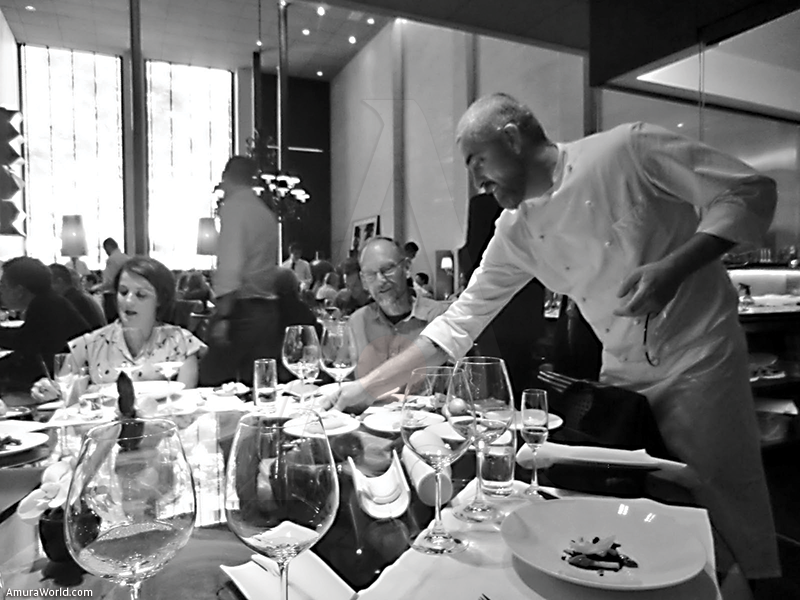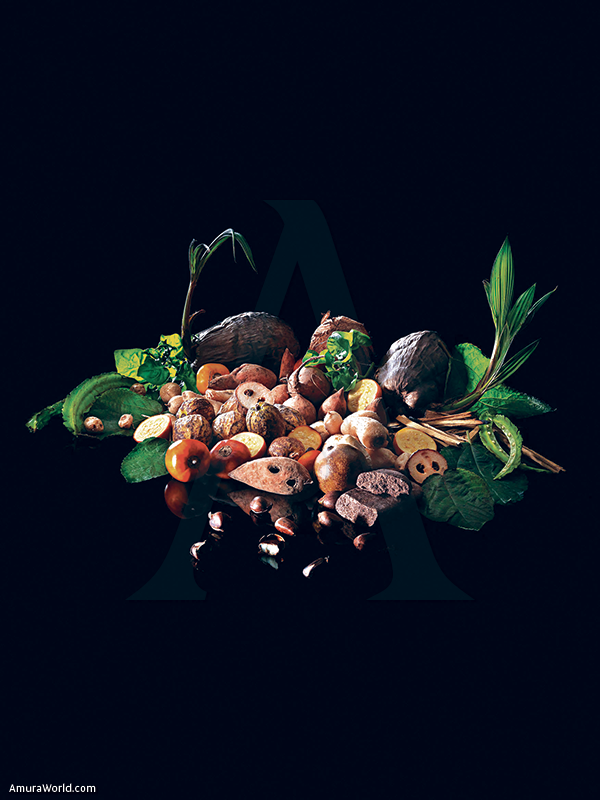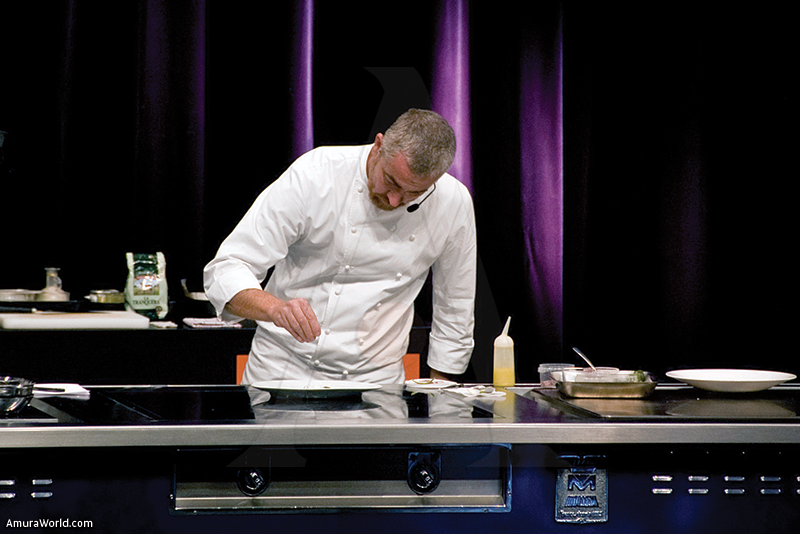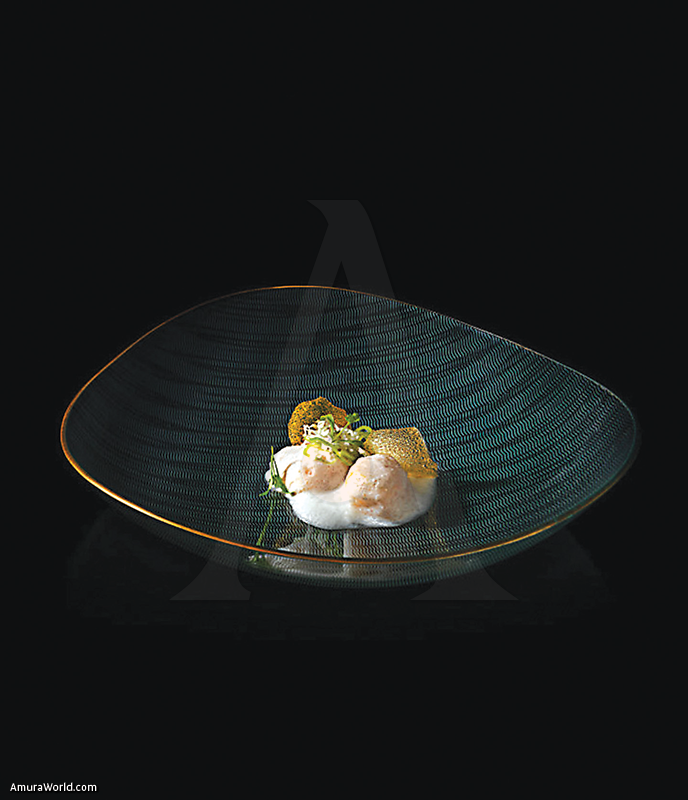The flavors of Brazil
1. How is your gastronomic philosophy communicated to your diners?
DOM restaurant is the Brazilian Embassy for Gastronomy.
2. You were trained with classical culinary techniques in France and Italy. How have you been able to reconcile the European executions with the Brazilian ingredients?
Back in your home city, native haute cuisine is more Italian and French than Brazilian and traditionally family dishes, such as rice and beans, are considered too homely to be served in a top restaurant. This is what confronted me on my return from Europe in 1994.While I was away I was not going to be able to cook French food as well as France’s native chefs and that made me look at my own culinary heritage. Many of the ingredients you can buy in the market at Belem do Para (a city on the Amazon delta) are unfamiliar to the majority of Brazilians. I realized that the first step was to subtly educate my Brazilian customers into appreciating their indigenous produce. I try to do this by taking native Brazilian ingredients, which are not used widely in restaurant cooking and heightening their taste by using classical culinary techniques, like the Palm Heart fettuccine dish. At the heart of my cooking there is the staple “mandioca” or the “pirarucu” fish, a huge Amazonian river fish that weighs up to 300Kg.
3. What do you find most inspiring about Brazilian food? What is it about it that speaks to you?
The restaurant scene in Brazil is growing and changing at a great rate in terms of quality and options. It really is a city to watch. It is certainly very different from the European dining scene due to the ingredients available really only in Brazil.
4. You’re known as an “ambassador of Brazilian flavors and culinary arts”. What is the major thing you want to teach the world about Brazilian food and your heritage?
I believe that European and Brazilian ingredients merry pretty well. When we opened it was a first, now the landscape has changed. For me it is important to put Brazilian ingredients on the global food stage and when I speak with younger chefs I encourage them to find their own way, develop their own style to use Brazilian ingredients.
5. You have travelled around Brazil to discover new ingredients. What did you learn in your journeys? Did you discover new things about Brazilian culture and people as well?
All started when I found out that there isn’t any kind of edible mushroom in the whole country! That’s why I hooked up with anthropologist and scientists here, they are trying to discover and classify new products, including foods from the Amazonian region.
6. You’ve been known to work with some unique ingredients. What is the most surprising or particular ingredient you’ve ever used?
I visit the local tribes quite regularly. One of my favorite discoveries is a fragrant Amazonian root called “priprioca”. The natives here use it as a scent rather than food. So, I decided to use it like an essence, with help of a perfumer, I developed an extract that I can use in both savory and sweet dishes. (laugh)
7. Having rocketed from anonymity to a culinary sensation, how do you deal with the pressure? Do you feel comfortable in the limelight?
Inside the kitchen l love the pressure and need to be perfect at speed.
There are no similarities between being a rock star and being a chef, but between music and being a chef- yes. There has to be a balance with what you want to do and what the public wants to hear or eat and I must create the right atmosphere to deliver what I want to my audience.
8. One of your goals is to see more awareness about native Brazilian food, both inside and outside the country. How do you plan to achieve this goal?
My aim for Brazilian food is to encourage sustainable development, environmental methods of farming new products while at the same time protecting the forest and the vulnerability of its indigenous tribes.
9. Aside from ingredients, what would you say makes Brazilian cuisine special?
It is like SAMBA!
10. What changes or developments do you want to see in the future of fine dining?
I would like to see chefs and retailers work together to protect this fragile world we live in.
11. For gourmet travelers going to Brazil, what is the one thing they absolutely have to eat?
The palm heart fettuccine
12. You were once a DJ. Are you still an active music fan? Do you see that experience useful in your current career as a chef?
It was Great! I was in my late teens and was growing up. I love music and to listen to it alone at this time.
13. What percentage of locally sourced ingredients do you use in your restaurant?
Between 80 and 90%. That’s why we tend to change our Tasting Menu quite regularly. We use plenty of ingredients from the Amazons and the only ‘non-local’ ingredient is perhaps olive oil.
14. How does your menu reflect local food heritage?
We have been using Brazilian ingredients every day for over ten years now. This appears to have inspired a new generation of chefs and all this has created a demand in the market. In that way indigenous people and small producers have been largely supportive.
15. In which environmental initiatives are you involved with?
We have created “Retratos do Gosto” a label that commercialises Brazilian ingredients, with the same control concept as “fair trade”.
16.Is there any educational initiatives you are involved with?
I am involved with GASTROMOTIVA. It is an NGO that focuses on the professional development of teenagers who have social problems; it has the aim of creating values in the community. The objective is to encourage unprivileged Brazilian youth to enter the gastronomic labour market with professional skills and also to create new businesses within their communities. Together we have also created a “short chef course” inside prisons, which have been very successful but never publicised.
17. What captivated you about cooking?
It’s a link between two worlds. The one nature gave us and the one made by man.
18. What drives you to create and innovate food?
I often become inspired by Heitor Villa-Lobos who was a Brazilian composer, described as the single most significant creative figure in 20th-century Brazilian art music.
19. The food you find most fascinating?
The food created by chefs. They tend to create dishes that transcend cultural barriers.
20. Your all-time favorite ingredient?
Salt, with out a doubt
21. Where did the idea for DOM come from?
When I returned to Brazil in ‘94 after a number of years in Europe, I worked as a chef in other restaurants but it was always my dream to open my own, combining Brazilian ingredients with European techniques. D.O.M. opened in 1999 and continues to be the realization of that dream.
22. What’s the secret of DOM’s success? How important is the concept, the food, the people?
It’s all in the ingredients, those unique to Brazil; it is the taste of the Amazon. D.O.M is what Brazil tastes like.
23. Was opening Dalva e Dito easier than opening D.O.M? Did you do anything differently when planning and launching it? How does it differ from D.O.M?
It was not easy but it was easier than opening D.O.M. The concept is quite different Dalva e Ditto it is a Brasserie main focus is on Brazilian heritage food, everyday dishes like Rice & Beans.
24. What made you decide to become a chef?
Music. Becoming a chef was a way to support my love of music. Originally my love for cooking surpassed my first love!
25. What do you love most about being a chef?
Inside the kitchen l love the pressure and need to be perfect at speed. Outside I love experiencing the world as a chef, it is exciting, it has pulled my life in many wonderful directions.
26. What other ambitions do you have?
My ambition is to encourage the use of gastronomy for conservation and preservation as well as the purchase of ingredients with conscience. At D.O.M we purchase from the people in the Amazon, ingredients such as Tucupi which is used in our Mushroom Consome which portray Amazonian Rain Forest flavors. My vision is one of Eco-Gastronomy.
27. What’s your signature dish?
Amazonian Fish with Tucupi and Tapioca
28. What is your Favorite kitchen utensil?
Knives, they are an extension of a chef’s hand.
29. If you had a dinner party, who would you invite over?
Jean Anthelme Brillat-Savarin, he was a French philosopher. His famous work, Physiologie du goût (The Physiology of Taste), had a profound effect on me.
30. Is there a fellow chef you admire most and why?
There are so many, Heston Blumenthal, Ferran Adria, Andoni Aduriz. However, it is Escoffier and Fernand Point who truly inspired me in this journey.
Scallops with coconut milk, aromatic pepper and crispy mango
Serves 4
AROMATIC PEPPER OIL
- 200 g aromatic pepper
- 30 ml cachaça
- 15 ml white vinegar
- 1 bunch rosemary
- 1 bay leaf
- 1 clove garlic
- 750 ml canola oil
Preparation
- Place all the ingredients in a vacuum pack.
- Place the pack in the sous-vide at 8°C and infuse for 30 days.
MANGO CRISPIES
- 1 vanilla pod
- 150 g fresh mango, stone and skin removed
- 44 g glucose
Preparation
- Preheat the oven to 130°C.
- Cut the vanilla pod lengthwise and scrape out the seeds.
- Place the mango and the vanilla seeds in a blender and process.
- Pass through a fine sieve into a clean bowl and set aside.
- In a small pan over low heat melt the glucose and stir it into the mango and vanilla mixture.
- Spread the mixture in very thin layers on a silpat and bake for 35-40 minutes, or until crunchy. Store in a cool, dry place.
SCALLOPS
- 12 scallops (cleaned)
- 25 ml lemon juice
- 150 ml coconut milk
- 10 ml aromatic pepper oil
- 10 g mint leaves
- salt
Preparation
- Place the scallops in a bowl and place in a bain-marie filled with ice.
- Add the lemon juice and some salt, mix together and marinate for 2 minutes.
- Add the coconut milk and the aromatic pepper oil. Mix thoroughly.
- Cut the mint leaves into chiffonade and add to the mixture.
FINISHING TOUCHES AND PRESENTATION
- Arrange 3 scallops in a soup plate and pour a little of the coconut milk marinade over them.
- Garnish with one mango crispy, some coriander sprouts and the fresh aromatic pepper.
Text: AMURA ± Photo: 2013 Phaidon Press / Dobby ssignature / Staic






